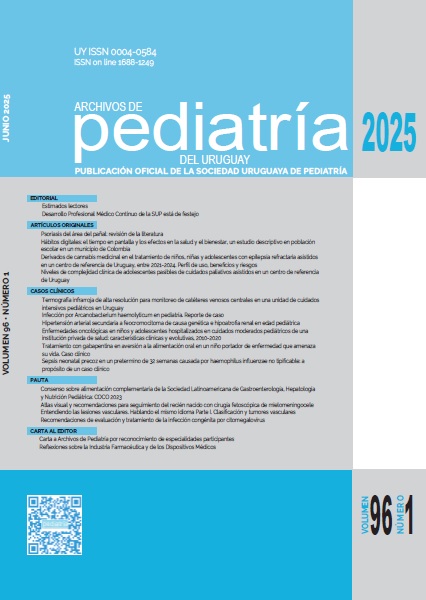Abstract
Introduction: many children with life-threatening conditions (LTC) require, in their first months of life, prolonged stays in intensive care. Once the critical stage has passed, they frequently present difficulties in initiating feeding: food rejection or aversion and early satiety. This could be interpreted as a “neuropathic pain-like” mechanism secondary to the repeated painful and unpleasant oral stimuli of invasive procedures in the mouth and neck. The literature proposes that a therapeutic trial with drugs indicated for the treatment of neuropathic pain such as amitriptyline or gabapentin could contribute to the resolution of this problem.
Clinical case: child, 1 year 9 months old, with Di George syndrome, complex congenital heart disease for which he underwent surgery on two occasions, severe chronic malnutrition, hypoparathyroidism, hypogammaglobulinemia with lymphopenia and tracheostomy. He had a persistent aversion to oral feeding and was treated with oral gabapentin with good clinical response: progressive acceptance of oral feeding that allowed removal of the nasogastric tube and sustained weight gain.
Discussion: painful experiences secondary to invasive treatments performed on children with congenital heart disease and other LTC could determine sensitization of peripheral nociceptors, activation and excitation of the central nervous system and hyperalgesia with consequent oral discomfort, odynophagia, dysphagia, early satiety and rejection of meal. Gabapentin could be considered an effective drug to inhibit these mechanisms, prior to defining interventional measures such as a gastrostomy, which add greater complexity to the approach to children.
References
Davis A, Bruce A, Mangiaracina C, Schulz T, Hyman P. Moving from tube to oral feeding in medically fragile nonverbal toddlers. J Pediatr Gastroenterol Nutr 2009; 49(2):233-6. doi: 10.1097/MPG.0b013e31819b5db9.
Bruce A, Davis A, Baum C, Chepolis D, Kolomensky A, Monagas J, et al. Retrospective study of gabapentin for poor oral feeding in infants with congenital heart disease. Glob Pediatr Health 2015; 2:2333794X15591565. doi: 10.1177/2333794X15591565.
Indramohan G, Pedigo T, Rostoker N, Cambare M, Grogan T, Federman M. Identification of risk factors for poor feeding in infants with congenital heart disease and a novel approach to improve oral feeding. J Pediatr Nurs 2017; 35:149-54. doi: 10.1016/j.pedn.2017.01.009.
O'Mara K, Islam S, Taylor J, Solomon D, Weiss M. Gabapentin improves oral feeding in neurologically intact infants with abdominal disorders. J Pediatr Pharmacol Ther 2018; 23(1):59-63. doi: 10.5863/1551-6776-23.1.59.
Ayres J. La integración sensorial y el niño. México: Trillar, 1998
Zangen T, Ciarla C, Zangen S, Di Lorenzo C, Flores A, Cocjin J, et al. Gastrointestinal motility and sensory abnormalities may contribute to food refusal in medically fragile toddlers. J Pediatr Gastroenterol Nutr 2003; 37(3):287-93. doi: 10.1097/00005176-200309000-00016.
Hauer J, Solodiuk J. Gabapentin for management of recurrent pain in 22 nonverbal children with severe neurological impairment: a retrospective analysis. J Palliat Med 2015; 18(5):453-6. doi: 10.1089/jpm.2014.0359.
Collins A, Mannion R, Broderick A, Hussey S, Devins M, Bourke B. Gabapentin for the treatment of pain manifestations in children with severe neurological impairment: a single-centre retrospective review. BMJ Paediatr Open 2019; 3(1):e000467. doi: 10.1136/bmjpo-2019-000467.
Asociación Española de Pediatría. Comité de medicamentos. Ficha de Gabapentina. Disponible en: https://www.aeped.es/comite-medicamentos/pediamecum/gabapentina. (Consulta: 24 enero 2024).
Hauer J, Houtrow A. Pain assessment and treatment in children with significant impairment of the central nervous system. Pediatrics 2017; 139(6):e20171002. doi: 10.1542/peds.2017-1002.
Drake R, Prael G, Phyo Y, Chang S, Hunt J, Herbert A, et al. Gabapentin for pain in pediatric palliative care. J Pain Symptom Manage 2024; 67(3):212-222.e1. doi: 10.1016/j.jpainsymman.2023.11.011.
Allen C, Canada K, Schlueter S, Zhang X, Bartlett H. Gabapentin can improve irritability and feeding tolerance in single ventricle interstage patients: a case series. Pediatr Cardiol 2023; 44(2):487-93. doi: 10.1007/s00246-022-03009-5.
Hauer J. Identifying and managing sources of pain and distress in children with neurological impairment. Pediatr Ann 2010; 39(4):198-205; 232-4. doi: 10.3928/00904481-20100318-04.
Edwards L, DeMeo S, Hornik C, Cotten C, Smith P, Pizoli C, et al. Gabapentin use in the neonatal intensive care unit. J Pediatr 2016; 169:310-2. doi: 10.1016/j.jpeds.2015.10.013.
Asaro J, Robinson C, Levy P. Visceral hyperalgesia: when to consider gabapentin use in neonates-case study and review. Child Neurol Open 2017; 4:2329048X17693123. doi: 10.1177/2329048X17693123.
Warlow T, Yates J, Taylor N, Villanueva G, Koodiyedath B, Griffiths L, et al. APPM Guidelines supported by Cochrane Response. Gastrointestinal Dystonia in children and young people with severe neurological impairment in the palliative care setting. London: APPM, 2023. Disponible en: https://www.appm.org.uk/_webedit/uploaded-files/All%20Files/Clinical%20guidelines/GI%20dystonia%20guidelines.pdf. (Consulta: 24 enero 2024).

This work is licensed under a Creative Commons Attribution 4.0 International License.
Copyright (c) 2025 Archives of Pediatrics of Uruguay


